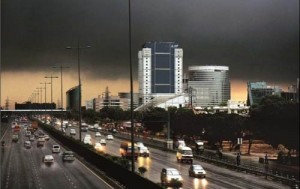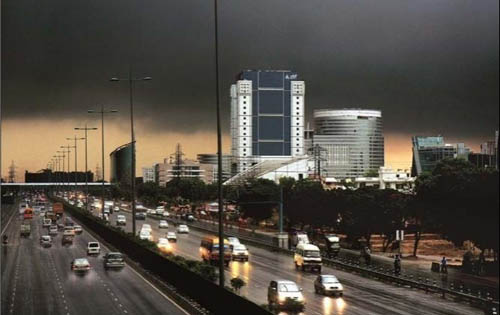By: Ravi Sinha
 Central Business Districts (CBDs) are supposed to be the lifeline of the city and a mirror of the economic activity and real estate market trend. However, the real estate boom in the last over a decade now, added to the leaps and bounds growth in the economic activity has upset the conventional outlook over the CBDs and the traditional business centres across the country are fading away as the benchmark of economic activity. The economic upswing has fuelled the infrastructure growth that has led to the concept of suburbs. Hitherto seen as the second choice for the business and living, gradually these peripheral centres have started redefining the concept of business districts. Today the CBDs in almost all major cities are losing sheen to the PBDs (Peripheral Business Districts).
Central Business Districts (CBDs) are supposed to be the lifeline of the city and a mirror of the economic activity and real estate market trend. However, the real estate boom in the last over a decade now, added to the leaps and bounds growth in the economic activity has upset the conventional outlook over the CBDs and the traditional business centres across the country are fading away as the benchmark of economic activity. The economic upswing has fuelled the infrastructure growth that has led to the concept of suburbs. Hitherto seen as the second choice for the business and living, gradually these peripheral centres have started redefining the concept of business districts. Today the CBDs in almost all major cities are losing sheen to the PBDs (Peripheral Business Districts).
It all started with Gurgaon in the NCR coming into prominence for the multinationals and FDI compliant business, then Navi Mumbai got the big ticket projects over its traditional CBDs in South Mumbai. Experts believe traditional CBDs were designed by the town planners who had no exposure to the international CBDs. The businesses then were local and catered to an economy with a GDP of 1 per cent of that time. Now India a global economy, with GDP of 9 per cent and above, needs global thinking in the design and the real estate conducive to this is not in the Metros, but in the satellites destinations to such metros, like Gurgaon to Delhi and New Mumbai to Bombay.
Atul Modak, Head of Kohinoor City agrees to it when he says that it is no longer a matter of pride to have an office in Nariman Point in Mumbai. “ICICI, National Stock Exchange, Reserve Bank of India so much so that even our prestigious diamond bourse, all have set up their offices at BKC, not to speak of MCA, Asian Heart Hospital and Dhirubhai Ambani International School. The American Consulate too is shifting to BKC. In spite of this, Nariman Point still remains one of the priciest commercial areas in the world making it even more unviable. Look at the influx of new offices in Upper Worli, Andheri, Malad, Powai etc making them the new CBDs in demand. That speaks for itself. Other factors influencing this trend could be the connectivity, infrastructural development and proximity to residences,” he says.
Madhusudan Thakur, Country Head, Regus suggests that apart from the standard concerns of infrastructure, safety and ageing buildings, another major concern is commuting, largely many companies want to be nearer to their employees, which can mean an alternative location is more desirable, therefore assets in CBDs do present a challenge. “Smart companies have realized that the answer to the challenges posed by the lack of options in CBDs is a blend of different types of working that put employees where and when they need to be there. For some companies, this will be a distributed workforce, across a wide variety of locations such as home, a CBD office and remote locations such as business centers. Actually any day of the week you can see this at our own Regus business lounges, which give corporate members access to our network of 30 centres across the country,” he says.
Sunil Dahiya, Managing Director of Vigneshwara Developers that has recently launched a SOHO (Small Office Home Office) in Gurgaon as the next generation of PBDs believes India is taking a tectonic shift from 2G to 3G in all spheres, be it telecom to automobiles to banking. Therefore real estate cannot be behind and has to adapt to the new generation Indian and global expatriates working out of the CBDs.
“For a knowledge worker in the traditional CBDs 50 per cent of his CTC is spent on the road traffic and his personal performance is undervalued by half. Therefore, at an annual rental starting at 4.5 lakhs, it makes prudent sense for any corporate to give a SOHO in the CBD to its top executives, making ‘walk-to-work’ for faster mobilisation of human resource. The pattern of Mon to Friday working out of a SOHO and a weekend getaway to a lavish farm on the outskirts for his weekends is going to be witnessed. A quick power nap of an hour in a SOHO within the CBD will energize the executive for another 5-7 hours of productivity through the late night office hours,” he says.
Harinder Dhillon, VP, Marketing, Raheja Developers agrees that SOHO is the future and world over the economy is adopting it in a big way since that is the need of the hour. He, however, still finds traditional CBDs a value for money. “If we look at Connaught Place in Delhi or Nariman Point in Mumbai, these markets have revived in a very big way on capital values as well as lease rentals. A similar story has unfolded on Anna Salai in Chennai & Bangalore MG Road/Brigade Road,” he says
Story Update
The Central Business Districts (CBDs) started losing out to Peripheral Business Districts (PBDs) due to the corporate preference for lower commercial rentals and lower cost of doing business per square feet. It had a domino effect on residential real estate as well. However, post the Covid-19 the dynamics of CBDs and PBDs changed completely. While the PBDs have a clear edge over the CBDs, not just for lower costs but also more open spaces and remote working, the price appreciation post the pandemic has been far better along the peripheral locations than the city centers.
However, the PBDs that emerged as a lower cost competitor to the CBDs are also losing out now with stretching of the city limits. For example, places like Gurgaon or Manesar in Delhi-NCR or Thane in Mumbai are no longer PBDs but a city beyond city in itself. Now the new claimant for real estate attraction is places beyond these established once far off locations.
The small towns within the travelling distances from these places are seen as far better option than the established peripheral locations. Work From Home has completely changed the demand & supply dynamics of the property market. The only catch here is the infrastructure along the way. For example, urban infrastructure experts believe the widening of NH-24 would soon make a far off location like Meerut emerge like the PBD of the NCR region.
Track2Realty is an independent media group managed by a consortium of journalists. Starting as the first e-newspaper in the Indian real estate sector in 2011, the group has today evolved as a think-tank on the sector with specialized research reports and rating & ranking. We are editorially independent and free from commercial bias and/or influenced by investors or shareholders. Our editorial team has no clash of interest in practicing high quality journalism that is free, frank & fearless.
Subscribe our YouTube Channel @ https://bit.ly/2tDugGl





